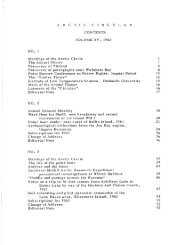Volume 11, 1958 - The Arctic Circle - Home
Volume 11, 1958 - The Arctic Circle - Home
Volume 11, 1958 - The Arctic Circle - Home
Create successful ePaper yourself
Turn your PDF publications into a flip-book with our unique Google optimized e-Paper software.
VOL, XI No, 4<br />
THE ARCTIC CIRCULAR<br />
68<br />
It was my good fortune to be nown from Sugluk to<br />
Deception Bay by a helicopter of the C ,G,S. Labrador to examine<br />
a site found by the Rev. David Ellis of Sugluk, who helped me<br />
with the excavation, Although stone caches and several stone<br />
houses were recorded, not a shred of animal bone or artifact<br />
was found. <strong>The</strong> site, therefore, cannot be dated at present,<br />
Anthropclogical field work at Great Whale River and Povungnituk,<br />
By Asen Balikci<br />
In 1957 and <strong>1958</strong> I was sent north by the Human History<br />
Branch of the National Museum of Canada to study the cultural<br />
changes that have taken place durinG the past fifty years among<br />
the Eskimo inhabitants in the Great Whale River and Povungnituk<br />
areas. From a description of the traditional elements that have<br />
been replaced by new ones and from the transformation of whole<br />
aspects of socio-culturallife, it is hoped to discover processes<br />
or tendencies of socio-cultural chanGe along the east coast of<br />
Hudson Bay. Such a study involves not only the mechanical<br />
replacement of traits but also internal factors of change such as<br />
redistribution of population, new group formation, inter-and intragroup<br />
tension, messianic -nativistic movements, and changes<br />
in kinship relations, <strong>The</strong> compa.rative nature of the study, which<br />
is based on data from several neighbouring communities, makes<br />
it possible to separate the processea of change from the primary<br />
data.<br />
-<br />
I<br />
<strong>The</strong> first field work towards this study was done in<br />
1957 at Great Whale River, a settlement where background data<br />
was available from the study made by J ,J, Honigmann during<br />
the summers of 1950 and 1951. <strong>The</strong> initial phase of the study<br />
inVOlved an examination of the new interactional system resulting<br />
from the arrival of a large number of white workers. <strong>The</strong><br />
effects of the employment opportunities which brought white men and<br />
Eskimos into daily contact have be~n discussed in a paper to be<br />
published by the National Museum. <strong>The</strong>y are as follows:<br />
1. Concentration at Great Whale River of most Eskimo<br />
groups traditionally spread alone the coast between<br />
Cape Jones and Richmond Gulf and a consequent<br />
disorganization of the local migl'ationa.<br />
. ,<br />
1. "Relations inter-ethniques a 1a Grande Riviere de la Baleine<br />
baie d'Hudson, 1957."












